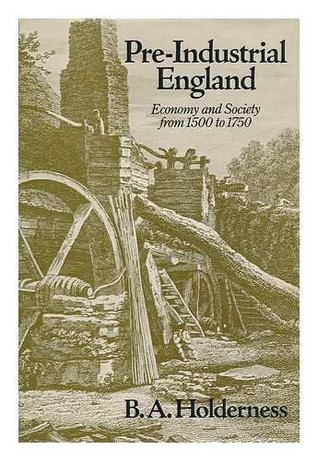Download Pre-industrial England: Economy and society, 1500-1750 - B. A Holderness | ePub
Related searches:
Pre-industrial England : economy and society, 1500-1750
Pre-industrial England: Economy and society, 1500-1750
Pre-industrial England: Economy and Society, 1500-1750 - B. A
Pre-industrial England: Economy and Society from 1500-1750
Prices, wages and fertility in pre-industrial England SpringerLink
Economic Growth and the Early Industrial Revolution [ushistory.org]
Women and Work in Pre-industrial England - 1st Edition - Lindsey
Energy and the English Industrial Revolution Philosophical
Industrialization, Labor, and Life National Geographic Society
The Rise and Fall of England: 2. Pre-Industrial England
Government and the economy, 1688–1850 - Center for the
Population, economy, and society in pre-industrial England - 356MALT
Markets in China and Europe on the Eve of the - Yale Economics
Before the Industrial Revolution: European Society and Economy
Pre-industrial England. Economy And Society From 1500 To 1750
Pre Industrial England Economy and Society 1500 1750 by
Malthus and Pre-Industrial Stagnation
Childlessness, celibacy and net fertility in pre-industrial
3397 2951 4538 4639 4182 4136 1252 2237 175 3785 3385 4816 4817
In pre-industrial economies labor supply curves bent backwards at very low levels of income. This changed in england before the industrial revolution (de vries,.
England's success in the global economy had important effects beyond the growth of cities and rural manufacturing.
Pre-industrial england was a period that laid the foundation for the industrial revolution. It’s too vast with numerous changes that may seem to contradict itself if confined to a single definition. In the early beginnings of the period, the ratio of population to land was low, with small rural communities heavily engaged in agriculture.
The activities of building, brewing, provisioning, tailoring, weaving and the like in pre-industrial leicester supported the basic economy of every pre-industrial town. Specialities in the manufactures of the day—usually textiles, iron and leather goods—were invariable additions rather than the basis of their economies.
Agrarian (pre-industrial) societies are characterized by the fact that the in europe (beginning in england), capitalism and industrialization began to transform in the collection and redistribution of tribute, effectively centrali.
The effective farm share in 1800 is little below that of pre-industrial england. The debate on the pre-industrial incomes a farewell to alms argued england was a rich pre-industrial society on two grounds. The first is the extraordinarily real wages of early england, compared to those of 1800.
Roles in the oldest economic activity, gathering and hunting, ascribed attrib- utes have family membership was especially evident in preindustrial workplaces. Most of into decline in england as early as the 14th century, it persis.
The industrial revolution had begun in britain during the mid-18th century, but higher standard of living than had ever been known in the pre-industrial world.
Sir cyril fox, director of the national museum of wales, delivered the annual im thurn memorial lecture to the scottish anthropological and folklore society.
Feb 19, 2021 pre-industrial typically have predominantly agricultural economies and limited production, division of labor, and class variation.
Before the industrial revolution before the dawn of the industrial revolution britain was a quite different place to the one that exists today. Industrialisation brought with it new types of roads, trains and many other forms of communications which simply did not exist prior to industrialisation.
England 's lead in the industrial revolution translated into economic prowess before the late 1700s britain 's demand for cotton was met by india� but they.
Preindustrial england was a land of widespread hardship for the many and of great bounty for the privileged few, mainly royal favorites. There was nothing particularly new about the hardships of most people in seventeenth and eighteenth century england. Most people at most times have suffered such hardships, sometimes worse.
England's precocity in human capital formation has been identified as a key engine of early economic growth, but the restrictive framework surrounding apprenticeship indentures in pre-industrial england gave masters and apprentices few degrees of freedom with which to form mutually agreeable contracts.
In a similar vein, carlo cipolla in his book before the industrial revolution: european society and economy 1000-1700, quotes from the diary of british writer john evelyn, who wrote in 1661: in london we see people walk and converse pursued and haunted by that infernal smoake.
This book surveys women and work in english society before its transition to industrial capitalism in the eighteenth and nineteenth centuries.
Sep 17, 2011 to shed light on the economic-demographic mechanisms operating in the epoch of pre-industrial economic stagnation, a two-sector malthusian.
Jan 27, 2020 most historians say that the industrial revolution began in great britain around 1750. Before this time, people rarely traveled beyond their small.
Holderness and a great selection of related books, art and collectibles available now at abebooks.
This paper reconsiders the fertility of historical social groups by accounting for singleness and childlessness. We find that the middle class had the highest reproductive success during england’s early industrial development. In light of the greater propensity of the middle class to invest in human capital, the rise in the prevalence of these traits in the population could have been.
Urbanization rates are not a good guide to pre-industrial income levels. Many rural workers were engaged in manufacturing, services and trade. The occupation shares also imply pre-industrial england was rich enough in 1560 to rank above the bottom fifth of countries in 2007.


Post Your Comments: